In the Spring of 2017, I met this eccentric chap.


 Editor’s Note: This is merely a thought exercise by the author. The opinions reflected in the below narrative do not reflect the opinions of the teaware on staff . . . or this editor, for that matter.
Editor’s Note: This is merely a thought exercise by the author. The opinions reflected in the below narrative do not reflect the opinions of the teaware on staff . . . or this editor, for that matter.
Seriously, I just work here, guys.
A thought occurred to me over the years. No one has come to a clear consensus as to what the proper tea categories are. The general consensus is that there are six: Heicha (Dark Tea), Hong Cha (Black/Red Tea), Wulong, Green Tea, Yellow Tea, and White Tea. However, some say that yellow tea isn’t its own category (even though it clearly is). Others champion the stance that dark tea shouldn’t include sheng (raw) puerh. Others still believe puerh should be its own category. Hell, even some international trade laws only recognize two tea categories.
So, this got me thinking . . .
If I were the end-all/say-all authority on tea lexicography, how would I divvy up the different tea types? What would my breakdown look like? Well, in order to answer that question, I must breakdown (and in some cases, outright destroy) existing trends. This might over-complicate the issue, and over-simplify other things. But this is my write-up . . . and I’ll do what I want. So, here we go:
*dons helmet*
I “heart” the Doke tea estate.
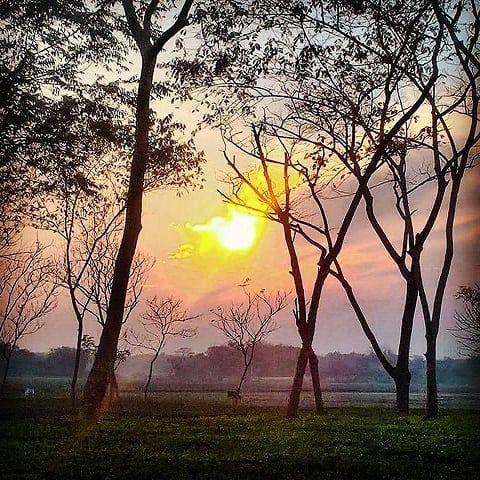
Photo by Rajiv Lochan.
No, I’m not ashamed to use the word “heart” instead of “love”. Especially today. Okay, I winced a tiny bit at the grammatical incorrectness of it (and the cutesiness of it) . . . but the sentiment still stands. And, given when this blog is going up, the cutesy incorrectness is fitting.
Begin Doke Diary transmission.
I’ve already written about the Doke tea estate in Bihar, India on several occasions. Everyone who reads this blog already knows my leanings toward it. That being, it’s my absolute favorite Indian tea garden. Yes, in all of India.

Photo by Rachiv Lochan.
But out of the countless tea profiles, taster notes, and lapses in narrative judgment, there is one thing I haven’t done. I haven’t had the opportunity to try all four of Doke’s teas from one season, in one year, in one day. That is, until Lochan Tea supplied me with such an opportunity.
A little over a year ago I made the acquaintance of Raj Vable of Young Mountain Tea.

We met up for lattes at Tea Bar PDX (where the above picture was taken), and he passed some samples on to me. Including an interesting Nilgiri black tea that I took a liking to. But that wasn’t the only reason for his visit. He was also starting up a rather ambitious Kickstarter campaign, and he wanted some help spreading the word.
NaNoTeaMo, Day 16: “Darjeeling Tea Fit for an Emperor”
The Singbulli tea estate has a very old history, like a lot of such Darjeeling gardens. It was established in 1924 by British planters, and then was taken over in 2003 by Jayshree Tea and Industries. The garden resides near the town of Mirik, and teas from there are certified organic.
The name “Singbulli” means “home of the birds”, but when I first heard the name several years ago, I immediately pictured this.
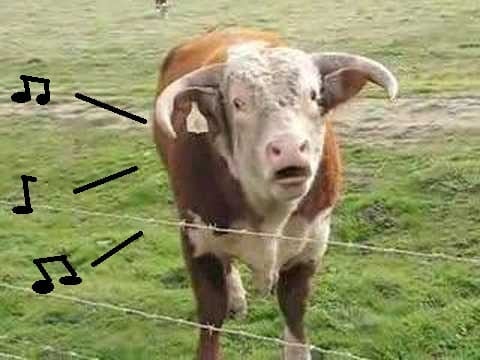
But let’s stay focused here.
Back in May – as all two of you readers may already know – I attended my third World Tea Expo. The Finest Brew’s booth was easily a tea blogger favorite. The company was run by two Sri Lankan borthers, and they possessed some weird things I’d never seen before. They had no problem showing off their weird wares to us.

Before leaving the Expo, they made it a point to gift me with two unique white teas. Both were made in the same style – that of Yue Guang Bai (Moonlight White), a white tea from Yunnan province, China. The kicker though? Only one of them was from Yunnan. Yiwu Mountain, to be precise.
The other was produced on a small plot of land on the New Vithanande tea estate in southern Sri Lanka (Ceylon).
What was even weirder; both teas were produced using the same cultivated variety of tea plant – a so-called “purple leaf” cultivar of assamica. The only differences between the two white teas was their terroir and age. The Yunnan-produced stuff was crafted in 2011, whereas the Sri Lankan batch was harvested in 2014. It was only a matter of time before I subject them both to a side-by-side . . . tea fight.

At the end of June, Portland, Ore. was dealt one of its most severe heatwaves in recent memory. And I got the flu during it. A mere week ago, we were dealt another STRONGER heatwave . . . and I got the flu again. That’s eerily coincidental.
Luckily, I caught this one in time and doused myself with various forms of ‘Quil on the market. That and I offset the medicine head with copious amounts of apple cider vinegar and lemon juice. But of course, there was also the issue of what tea to drink.
For most normal people that isn’t an issue, but tea still had to play an integral part somewhere. When knee-deep in flu-plague the recommended real tea is white tea. Straight-up young tea leaves and buds that are withered, dried and nothing else. They supposedly have antiviral properties, but – like the downy furs on the leaf buds – the science is a bit fuzzy on that claim.
The problem with most white teas, though, is that they aren’t strong enough. Okay, not entirely true. White tea leaves actually possess more caffeine than any other type because of their minimal processing. However, for most types to taste any good, they have to be brewed as light as possible. Boiled to death, yes, one would get the necessary daily-start caffeine wallop, but the brew itself would taste like a grassy turd. There are exceptions to this, but they’re hit or miss.
My phlegmatic redemption lay in the form of two freakish teas from Norbu Tea I had in my repertoire that – as per usual – I had yet to get around to writing about. There were pu-erh teas out there that were made from young tea leaves and buds.
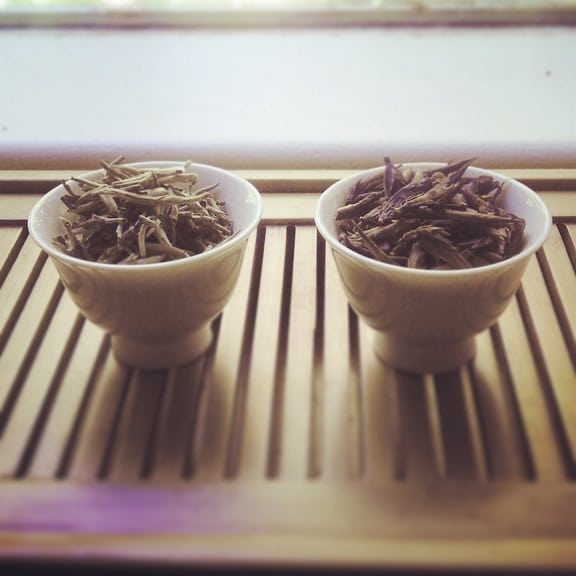
This all started with a forum topic. Tea Trade’s resident Smiling Frenchman – Xavier (of the Teaconomics blog) – had posted a discussion starter. It was aptly titled: “The First Scottish Tea is White and Smoky”
That immediately held my attention. In the discussion, Xavier posted a link to an article about a new outfit dubbed The Wee Tea Company, who had set up their own tea garden. In Scotland! Not only that, but they had also brokered an exclusive deal with the British high-end store – Fortnum & Mason. The asking price? £35 for 15g. That’s, like, $53 in ‘Merican money.
To their credit, though, the two teas they were producing were quite special. One was a regular white tea, while the other was a smoked white tea. Yes, smoked! Like a Lapsang Souchong, but instead of using pinewood, they used beech trees.
The garden itself was called the Dalreoch Tea Estate (aka. The Wee Tea Plantation).
“Dalreoch” loosely translated to “the field of the King” in Scots-Gaelic. Said garden was nestled in the Strathbraan valley at the foot of the Scottish Highlands, just outside of the small town of Amulree in Perth & Kinross County. The garden was originally a test plot purchased by one Tam O’Braan geared toward the development of degradable polymers for agricultural use. Later, however, he teamed up with Derek Walker and Jamie Russell of The Wee Tea Company (based in Fife) to start a tea garden.
They broke ground in 2012 with roughly 2,000 tea plants to start. While Scottish weather was temperamental at best, the lads developed clever ways to help the plants thrive. The aforementioned polymers helped the soil retain moisture, and kept pests from feeding on the young plants. As the tea bushes matured, they were then covered in UV-protective plastic tubes to restrict photosynthesis. During the harsher winter months, the plants were fully covered to prevent die-off. In 2014 – just a little over two years – they plucked their first leaves, for the first ever Scottish white tea.
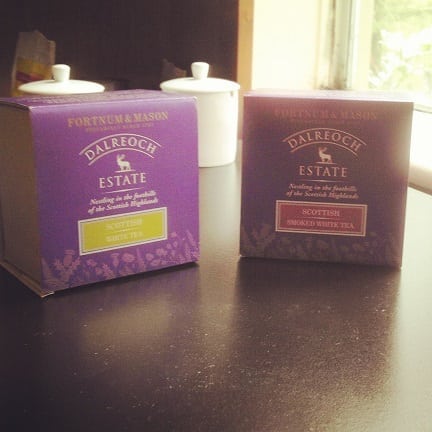
The question wasn’t whether or not I wanted it, but how I could bloody well get a hold of it. Neither The Wee Tea Company or Fortnum & Mason delivered to the U.S. I wasn’t worried about the money, per se. I would’ve sold a kidney to scrounge up the cash, if I had to.
I did the only thing I could do. I played the ol’ “tea blogger” card and hoped for the best. That . . . went about as well as expected.

After all, I was small-time compared to all the other outlets that were covering the garden – STiR Tea & Coffee, The Daily Mail. Hell, even The BBC.
My only answer was to utilize some of my (albeit few) UK contacts and see if they could make the purchase on my behalf. In the interim, I counted pennies. Unfortunately, that was taking far longer to do than I thought. My kidney was dreading my eventual decision.
A savior appeared in the most unlikely of places. For about eight years, now, I had a penpal. We’ll call her “Mistress G”. She was a tea drinker, but not one of my regular tea contacts. I’d never met her in person. Mistress G just happened to be residing in the U.K. In a passing conversation, I told her about my interest in the Dalreoch smoked white tea.
She said, “Oh, I can get that for you.”
I replied with, “There’s no way I can pay you back for that.”
She countered with, “Don’t worry about it, consider it a gift.”
I had my very own mysterious, tea-swigging, philanthropic Carmen Sandiego.

The package arrived in record time, a week later. In it, she also included a tin of chocolate pearl cookies, handmade Earl Grey shortbread from Edinburgh, and a tea napkin! All from Fortnum & Mason. My eyes glazed over.

After making short work of the Earl Grey shortbread, I bee-lined to the tea tins.

Scottish White on the left; Smoked Scottish White on the right.
The regular Scottish white tea had beautiful young, whole leaves and stems with a bouquet of colors ranging from green to brown. The aroma they gave off was straight forest and mint, with a dash of earth. It reminded me of a Yunnan-grown Moonlight white. Yue Guang Bai was a very burly, salt-of-the-earth sorta white on first impression; so was this.
The smoked white was a different beast entirely. On appearance, the leaves and stems had a smaller cut, almost broken pekoe-ish appearance. It was more in line with a Bai Mu Dan, visually. As for the aroma . . . oh my, “Yum.” Smoked teas tend to have an alternating hickory, campfiery and peaty scent to them. This had that but with a slight fruity tang on the back-end. Like someone lit a caramel-dipped apple on fire.
Given the smaller leaf pieces and the scent, I could almost imagine how the conversation between the innovators went.

And then they punched each other in the face for solidarity.
For brewing, I went with a typical white tea approach – roughly 175F water and a three-minute steep for each. 1 heaping teaspoon of leaves in a 6oz. steeper cup.
Scottish White Tea
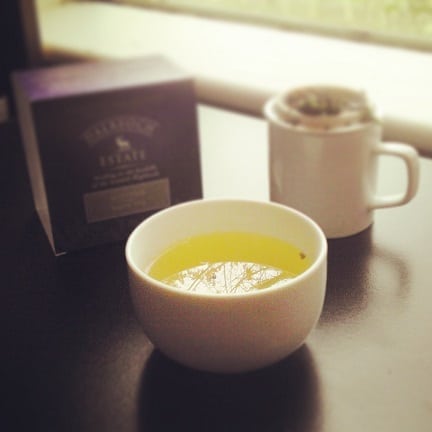
The regular white tea brewed to a vibrant yellow liquor with an aroma of berries, apples and spring leaves. This impression also echoed in the taste, which possessed a medium-bodied, creamy and fruit-sweet mouthfeel. It ended on a smooth, almost velvety finish with a lingering aftertaste of wilderness.
Scottish Smoked White Tea
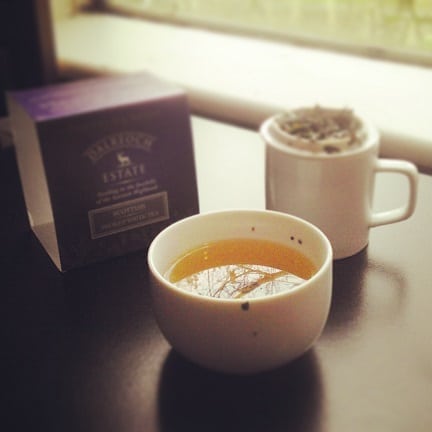
The smoked white brewed considerably darker, approaching Darjeeling amber in color. As for scent, well, it should be obvious. Straight peat moss and burnt wood wafted from the cup, but it was far more muted than I thought it would be. Not a negative thing at all, but a thankful subtlety that I wasn’t expecting. On taste, I was first greeted by whiskey, which then opened the door for chopped firewood, and courteously escorted an herbaceous finish.
I honestly can’t pick a favorite. White teas were the first loose leaf type I appreciated when my exploration was still in its infancy. Smoked teas appealed to my visceral, inner almost-manchild. On the one hand, I always appreciated the delicate and fruity aspects of tea. On the other, I liked to be hit in the face with blunt, burning trauma to my palate. I can’t decide, but what I can say is that this fledgling garden is off to a fantastic start.
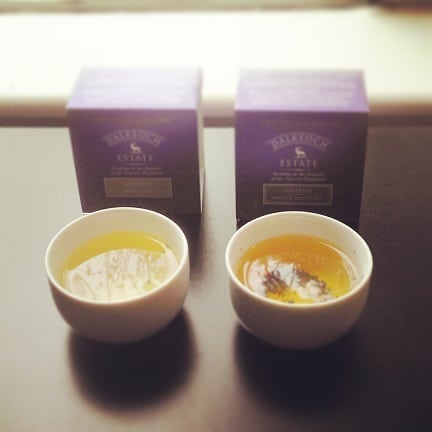
Would I pay $50-plus for their offerings? No. Of course, I’m probably saying that because I’m poor. For the moment, the price is slightly justified – both for the novelty and the rarity. Given that they’re only working with 2,000 plants – young ones, at that – they can easily ask for a higher price point for their yield. My hope is that when the operation expands, and more plants are introduced, that the price evens out a bit. With gardens in Northern Ireland, France, Switzerland and Italy going in, competition is bound to be fierce.
But they’re used to competition, aren’t they?
I’m just grateful this landed in my lap the way it did. And I can’t thank my mysterious benefactor enough. My diluted Scottish ancestry salutes ye, Mistress G.
UPDATE: I was just informed by one of the growers that they are now delivering globally. The last remaining stock can be purchased HERE.
This all started a year ago, and it’s all Greg’s fault.
By “a year ago”, I literally mean a year ago! Like, last August. And by “Greg”, I mean the dude behind Norbu Tea. One fateful day, in August of 2013, I noticed he had retweeted something interesting.

Alas, I’d seen the update too late. They’d sold out of that batch of Japanese white tea in less than two months. I even wrote about said lament in an article on Taiwanese white tea. However, they did encourage me to check back in a year – when the new harvest came in.
And wait, I did. Like some kind of deranged tea stalker.

Over the course of the year, I checked the site at least once a week. Hitting refresh a few times before moving on. That fierce determination lulled a bit in the spring months, but this last July…all that stalking paid off. A new batch had come in! Same location, same growing months, different cultivar.
For those not in the tea “know”, the Japanese don’t usually deviate from producing green tea. In recent years, that’s been a-changin’ – what with increased production in Japanese black tea, oolong, and in some cases, heicha. All that said, white tea was still undiscovered territory.
The farmer that devised this stuff hails from Gokase Town, Nishiusuki District, Miyazaki Prefecture, Kyushu, Japan. Say that five times fast. The region has had a healthy history of tea experimentation, particularly in oolong production. White tea, though, was a new venture. The farmer(s?) in question had only been at this style for two or three years.
The cultivar utilized for this batch was 100% Kanayamidori. From what I could find, it was registered in 1970 (source: My Japanese Green Tea), and is best known for producing very fragrant leaves. Ideal picking occurring in early-to-mid-May. The product I chose to buy was plucked around May 9th, and – according to Yuuki-Cha – was notably sweeter than later plucks. They had me at “sweet”.
Unlike Chinese white teas, these leaves were mostly un-tampered with. Plucked, withered and dried; no rolling that I could see, or at least not much. That and none of the leaves were “downy furs” young. They were youthful, yes, but more like toddlers in the leafy scheme of things. In appearance, they reminded me of Taiwanese white teas I’d tried. If I were a “Lay” tea person, I’d think these looked like lawn shavings. The aroma, though, would’ve dispelled that . It was note-for-note like Arya Pearl – a Darjeeling white of similar aesthetics – spicy on the nose with a grassy bend.
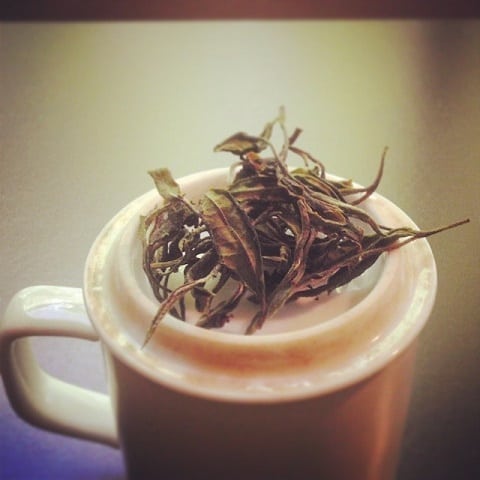
There weren’t any brewing instructions to go by on the Yuuki-Cha page, so I had to work with prior white tea knowledge on this. I went with roughly 170F-ish water and a three minute steep – roughly 1 tsp. of leaves in a 6oz. steeper cup. It worked for everything on the light end of the tea spectrum.
The liquor brewed a bold (if pale) yellow with an aroma of straight…well…sweetness. Not like a flavored tea, more like a fruit of some sort, but I’d be hard-pressed to narrow it down. It was just fruit-sweet on the nose. Same with the taste; first sip and I was whistling. This was perhaps the sweetest white tea I’ve come across since an Ali Shan Taiwanese white, or a Makaibari Silver Tips. Nothing about this outright screamed, “Nippon!”, save for a smidge of nuttiness on the aftertaste.
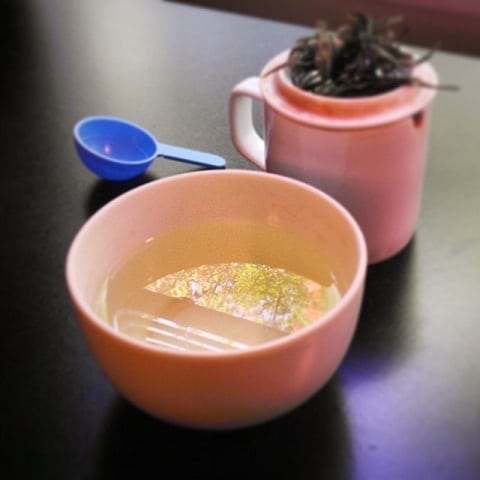
In baser terms, it was like a Taiwanese white tea seduced a Darjeeling white in a pachinko parlor, skipped town, and was greeted a year later with a bouncing baby Kanayamidori at its doorstep.
Worth the year-long wait? I’d say, “Mostly yes.”

Powered by WordPress & Theme by Anders Norén